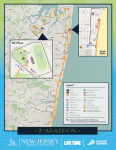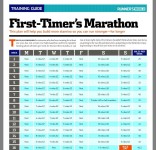
By CAROLINE BEATRICE
“You’re all crazy,” shouts crowd members gathered at the start of the New Jersey marathon. “You’d have to be nuts to do this.”
As runners look down, they make sure shoes are tied, headphones in, and silencing the white noise and internal fear, they embark on the next journey: 26.2 miles across Ocean County.
The gun sounds. The race has begun.

Giana DiTonto, 20, of Lyndhurst, at 19, ran the New Jersey marathon May 1, 2016, in 3:57.27, beating her goal time of 4 hours and 15 minutes.
In the 15-19 age bracket, only eight women had competed, and DiTonto had clinched 1st in her division and 808 out of all 1959 finishers. A 6-hour time limit is in place, and if not at the halfway point by 3 hours, runners are asked to leave the course.
“I wanted to run a marathon because it seemed like the ultimate runners‘ feat,” DiTonto said. “I had always admired marathon runners and their determination and I always wanted to be able to do that.”
Realistically, it is difficult for anyone to run a marathon, but for a busy college student it is even harder to find the time and motivation. It is crucial to begin training slowly, seeing as DiTonto is still young, it means forcing runs too quickly could lead to burnout. A large number of the top runners are right around 35 years old, now that DiTonto has started young, she can get years of practice and peak to become an even better runner.
Completing a marathon in sub 4 hours is a remarkable accomplishment, especially for a first time marathoner like DiTonto, who dove right into a marathon, rather than first running a half marathon, then later doing a full.
Completing a marathon takes months of dedicated training and careful preparation. This includes finding the perfect pair of sneakers that are supportive enough to run the training runs and withstand weather conditions. DiTonto, along with many other runners, prefers Asics as her top running shoe.

Training Regimen
A marathon involves a vigorous training schedule, that should be started approximately 4 months before race day.

With a hectic work 25-hour week as a medical assistant at the Women’s Center for OB & Gyn, commuting to Felician University as a biology/pre-physician’s assistant major, and being a student soccer athlete, DiTonto already had a full plate when she decided she wanted to run a marathon. Each week involves extensive training. The average woman runs a 9:55 minute mile, which means a 30-mile training week equals 5 hours a week spent solely on running.
DiTonto is currently signed up for the Half Sauer Half Kraut marathon, June 4, in Pennypack Park, Philadelphia.
“Lately, I have been pretty lazy because of school and work, but I run around three to four times a week. It’s pretty hard because I am just so busy and when I get home I just want to sleep or I have homework that needs to be done,” DiTonto said. “Once I am less busy I will definitely try to run everyday.”
When preparing for the New Jersey marathon, DiTonto ran everyday and followed the training plan nearly to a tee. Though this year she has found herself to be busier and not dedicate as much time to the training plan, she still regularly exercises and is in good shape because of her soccer practices.
She is confident she will be able to finish even though she has not had as much time as she would have wanted to train. Even though the run is physically demanding, if mentally strong and possible, it is achievable.
DiTonto uncovered her love for distance running when she began running track in high school. From then, she knew she would hold herself to a high standard when it comes to running.
“I realized I loved running during my freshman year of high school when I joined track. It was a great way to relieve stress, kept me in shape, and helped me form good friendships. It’s easy to like it because everything you get from running is positive.”
Tim Noakes, M.D., author of Lore of Running, has argued and proven through studies that the brain is what “allows or limits endurance performance rather than the body.”
DiTonto knows that she has already completed a marathon and that she is capable of doing another. She has taken what she has learned from last year and is applying it to her training regimen this year.
“I would definitely not run as much. Running 18 or 20 miles before a marathon is so unnecessary. Once you’re running it you’re just able to do it,” she said. “Running that much once isn’t going to make or break you. So for my next I definitely wouldn’t run over 15 miles in training runs. It just makes me tired.”
When fatigued, runners are more likely to develop injuries, such as torn ACL’s/MCL’s or rolled ankles. Once at the race, adrenaline is likely to keep the runner moving, and DiTonto notes that though training extensively helped her feel prepared, at some moments she felt overworked.
Training Tips
“When I’m 80, I want to be able to say I ran a marathon,” says Rachel Martin, 20 of Lyndhurst. “I’m just afraid that it will be too hard to train for and I will give up.” This concern is not uncommon amongst new runners: “Even though it will be hard, I have a friend that has never been a runner, yet she stuck to the training and completed a marathon as well, and if she can do it, it inspired me that I can too.”
When training, a large chunk of time needs to be designated to running each week, which leads many to fear they will not be able to designate enough time to training with their busy schedules.
Joelle Voza, 20, of Lyndhurst says, “I want to eventually be able to run a marathon.” She explains how she is constantly busy, but hopefully when she is older she will be able to make more time designated to training: “A marathon involves tough training and right now I just can’t stick to a regimen. I used to love running in high school, and I am excited to designate more time for it in the future.”
Anyone that has competed in a marathon can share what worked best, and these are the tips DiTonto would pass along for future marathoners.
“If it’s too cold outside when you’re training definitely skip that running day,” DiTonto said.
When training, it is important to complete the training runs to mimic what can be expected during race day; however, when the marathon takes place in May, training can begin in February where freezing temperatures and icy conditions can effect the quality of runs. If weather does not permit, do not force it; if applicable, move the miles around in order to accommodate what works best without putting the runner in a position prone to injury or passing out.
“Definitely eat a good meal the night before because you’re going to need all that energy, I personally had a huge bowl of pasta so the carbs would give me enough energy so I would have enough energy at the start,” DiTonto said. “When you’re running the marathon always drink the water or Gatorade and eat the bananas so you don’t pass out.”
It is crucial for runners to take the gels or bananas from the rest stops because from running nonstop, the body is being depleted of energy. Refueling is essential in order to make sure the body is properly hydrated and performing at it’s peak.
“Mind over matter” is the popular mantra runners tend to tell themselves: “Always think positive because there is no way you’re going to finish a race if you have negative thoughts,” DiTonto said.
Future Plans
Daily, DiTonto runs 3-miles in about 30 minutes when time and weather permits. She prefers to run outside, but most nights, she just runs on the treadmill. She likes to run as a stress reliever, but also loves the health benefits she reaps.
Her usual 3-mile route is:
“The only marathon I know I definitely want to run is the NYC marathon but I want to be able to run a marathon in all the states before I die,” DiTonto said. “I plan to run throughout my life to stay in shape and be healthy.”
In order to qualify for the NYC marathon, DiTonto would need to shave 44 minutes off of her time in order to meet the 3:13 time limit. This would mean she would need to be running a 7:22 pace in order to reach the time constriction.
Setting goals is what keeps DiTonto focused and on track. “I hope running like this will lead to me to eventually train for a triathlon.”
A triathlon is 0.9 miles swimming, 24.8 miles of cycling and 6.2 miles of running. It is recommended to designate about 12 weeks to train for this event.
One of the most rewarding feelings is being able to cross the finish line after 26.2 miles of endurance. “I feel like you need to run a marathon at least once in your life if you’re a runner.”
I really like the story, specially how it begins. It is really well written, very good quotes and videos and explains her story along with how important and the steps for training for a Marathon is. Very interesting, I learned everything I believe I could have learned about marathons training.